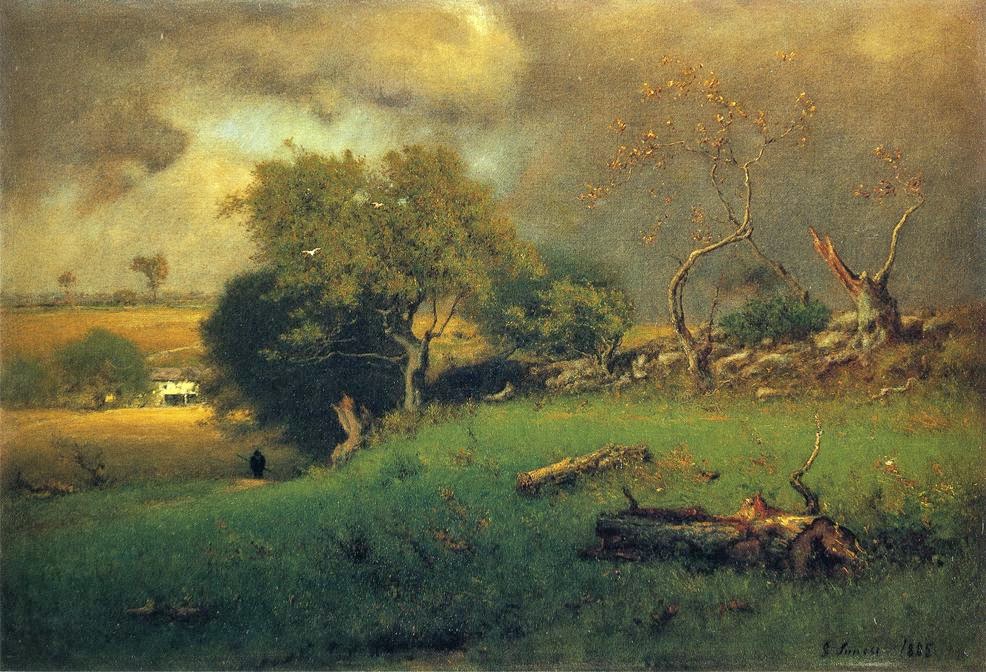« Born in Newburgh, New York, in 1825, Inness was a member of one of the most fertile generations in the history of American art. His contemporaries included many of the country’s greatest masters; for example, Sanford Gifford, Jasper Cropsey, Frederic Church, and Albert Bierstadt were all born within a few years of Inness. Not until the period following World War II was America again to see at one time so much talent in painting. Inness, it is worth noting, was six years younger than Herman Melville and Walt Whitman; he was five years older than Emily Dickinson, ten years older than Mark Twain. He was twenty-six when Moby-Dick appeared, twenty-nine when Walden was published, thirty at the time of the first edition of Leaves of Grass ».
_____________________________________________
 |
| Innes Georges - Christmas eve - 1866 |
______________________________________________
« The greatness of art is not in the display of knowledge, or in material accuracy, but in the distinctness with which it conveys the impressions of a personal vital force, that acts spontaneously, without fear or hesitation. »
George Inness
« We are all the subjects of impressions, and some of us seek to convey the impressions to others. In the art of communicating impressions lies the power of generalizing without losing the logical connection of parts to the whole which satisfies the mind. »
Georges Inness
__________________________________________________________
« The greatness of art is not in the display of knowledge, or in material accuracy, but in the distinctness with which it conveys the impressions of a personal vital force, that acts spontaneously, without fear or hesitation. »
George Inness
_________________________________________________________
George Inness
[1825 - 1895]
_________________________________________________________
« We are all the subjects of impressions, and some of us seek to convey the impressions to others. In the art of communicating impressions lies the power of generalizing without losing the logical connection of parts to the whole which satisfies the mind. »
Georges Inness
__________________________________________________________
 |
| Inness George - Home at Montclair - 1892 |
 |
| Inness George - Across the Hudson Valley in the Foothills of the Catskills |
 |
| Inness George - Afterglow |
 |
| Inness George - Etretat - 1875 |
 |
| Inness George - Georgia Pines |
 |
| Inness George - Gray Day, Goochland, Virginia |
 |
| Inness George - Lake Nemi - 1872 |
 |
| Inness George - Niagara - 1889 |
 |
| Inness George - November Montclair |
 |
| Inness George - October - 1884 |
 |
| Inness George - The Valley of the Olives |
 |
| Inness Georges - The valley of the Shadow of Death |
 |
| Inness George - Sunset over the Sea - 1887 |
 |
| Inness George - The Storm - 1885 |
 |
| Inness George - The monk |
 |
| Inness George - Moonrise - 1887 |
 |
| Inness George - Pool in the Woods |
 |
| Inness George - Sunset on the Passaic - 1891 |
 |
| Inness George - The Home of the Heron - 1893 |
 |
| Inness george - Early Morning, Tarpon Springs - 1892 |
 |
| Inness George - Early autumn Montclair |
 |
| Inness George - Sunset on Etretat |
 |
| Inness George - The Coming Storm - 1879 |
 |
| Inness George - End of Day, Montclair |
 |
| Inness George - Along the Jersey Shore |
 |
| Inness George - A Gray Lowery Day |
 |
| Inness George - Baberini Italy |
 |
| Inness George - Fisherman in a Stream |
 |
| Inness George - Monastery at Albano |
 |
| Inness George - St.Peter-s Rome |
 |
| Inness George - The Commencement of the Galleria Aka, Rome the Appian Way |
 |
| Inness George - the Trout Brook |
 |
| Inness George - Sunset |
___________________________________________________
« The purpose of the painter is simply to reproduce in other minds the impression which a scene has made upon him. A work of art does not appeal to the intellect. It does not appeal to the moral sense. Its aim is not to instruct, not to edify, but to awaken an emotion. »
___________________________________________
 |
| George Inness |
___________________________________________
« The true end of art is not to imitate a fixed material condition, but to represent a living emotion. »
http://www.nybooks.com/articles/archives/2008/sep/25/the-genius-of-george-inness/
« The works of George Inness, the American painter, have always provoked strong reactions and intense debate. Even at the height of his fame during the late nineteenth century, his landscape pictures disgusted some viewers, while moving others to rapturous praise. His critics called his paintings “diseased” and “perverted”; a reviewer in The New York Times in 1878 speculated that Inness might be insane. In the very same period, however, his fans—and there were many—lauded the “remarkable originality” and “depth of feeling” of the pictures. In their judgment, Inness was nothing less than the dean of American artists and one of the leading landscape painters in the world. For a time, Inness was both the most controversial and the most influential artist in the country. »

